On the roof of Milan’s Duomo amidst the spires and gargoyles and saints and angels, it’s noon on a late fall day and I’m here shooting. The sun shines over the city that spreads out like a bristling blanket; new skyscrapers and old bell towers puncture the worn brick and stone fabric of the town. At the edges, the Alps gleam, snowy in the distance. Above, the cathedral glows white against the sky. And all around me, friendly Romanian tourists in black jackets and thigh-high boots jostle, vying for vantage points from which to take pictures. They elbow in, admiring, snapping and clicking. Another group—this time from China—bursts from the stairs. Chattering and hopping about like hungry little sparrows, they freeze the landscape and their trip with hundreds of shots.
.
.
I retreat from the crush, thinking of Shelley and Tennyson and Henry James and Mark Twain who traveled here, part of their century’s onslaught: the privileged class that toured Italy, its monuments and museums serving as a finishing school. They climbed here too. Equally ecstatic but without cameras, armed with pens. They wrote letters to friends and poems for periodicals and chapters in books praising the Duomo. And of a different opinion, John Ruskin and Oscar Wilde came. They hated what they saw; their words were scathing.
.
On the rib of the roof, in the sun but with a brisk breeze stirring, I think of their descriptions and train my lens back on the cathedral, to see what they once saw.
.
At last, a forest of graceful needles, shimmering in the amber sunlight, rose slowly above the pygmy housetops, as one sometimes sees, in the far horizon, a gilded and pinnacled mass of cloud lift itself above the waste of waves, at sea—the Cathedral! We knew it in a moment.
Mark Twain, Innocents Abroad, 1869
.
This cathedral is a most astonishing work of art. It is built of white marble, and cut into pinnacles of immense height, and the utmost delicacy of workmanship, and loaded with sculpture. The effect of it, piercing the solid blue with those groups of dazzling spires, relieved by the serene depth of this Italian heaven, or by moonlight when the stars seem gathered among those clustered shapes, is beyond any thing I had imagined architecture capable of producing.
PB Shelley, letter to TLP Esquire, 1818
.
.
We wished to go aloft. The sacristan showed us a marble stairway and told us to go up one hundred and eighty-two steps…. We were tired by the time we got there. This was the roof. Here, springing from its broad marble flagstones, were the long files of spires, looking very tall close at hand, but diminishing in the distance like the pipes of an organ. We could see now that the statue on the top of each was the size of a large man, though they all looked like dolls from the street. We could see, also, that from the inside of each and every one of these hollow spires, from sixteen to thirty-one beautiful marble statues looked out upon the world below.
Mark Twain, Innocents Abroad, 1869
.
………………………………….I climb’d the roofs at break of day;
………………………………….Sun-smitten Alps before me lay.
………………………………….I stood among the silent statues,
………………………………….And statued pinnacles, mute as they.
Alfred, Lord Tennyson, “The Daisy,” 1851
.
Every face is eloquent with expression, and every attitude is full of grace. Away above, on the lofty roof, rank on rank of carved and fretted spires spring high in the air, and through their rich tracery one sees the sky beyond. In their midst the central steeple towers proudly up like the mainmast of some great Indiaman among a fleet of coasters.
Mark Twain, Innocents Abroad, 1869
.
The cathedral is a mixture of Perpendicular with Flamboyant, the latter being peculiarly barbarous and angular, owing to its being engrafted, not on a pure, but a very early penetrative Gothic … The rest of the architecture among which this curious Flamboyant is set is a Perpendicular with horizontal bars across: and with the most detestable crocketing, utterly vile. Not a ray of invention in a single form… Finally the statues all over are of the worst possible common stonemasons’ yard species, and look pinned on for show. The only redeeming character about the whole being the frequent use of the sharp gable … which gives lightness, and the crowding of the spiry pinnacles into the sky.”
John Ruskin, Notebooks, October 17, 1849
.The
The Cathedral is an awful failure. Outside the design is monstrous and inartistic. The over-elaborated details stuck high up where no one can see them; everything is vile in it; it is, however, imposing and gigantic as a failure, through its great size and elaborate execution.
Oscar Wilde, letter to his mother, 1875
.
While I study the roof, the Romanians finish taking pictures and sun themselves, propped against pinnacles. An hour or so later, they get up and file down the stairs, off perhaps to go Christmas shopping at Rinascente department store across the way. I follow them down but enter the cathedral to take pictures of the interior for this essay. Today’s strong sunlight blazing through the stained glass windows has set the somber interior burning.
.
The interior, though very sublime, is of a more earthly character, and with its stained glass and massy granite columns overloaded with antique figures, and the silver lamps, that burn forever under the canopy of black cloth beside the brazen altar and the marble fretwork of the dome, give it the aspect of some gorgeous sepulchre. There is one solitary spot among those aisles, behind the altar, where the light of day is dim and yellow under the storied window, which I have chosen to visit, and read Dante there.
PB Shelley, letter to TLP Esquire, 1869
The guide showed us a coffee-colored piece of sculpture…. The figure was that of a man without a skin; with every vein, artery, muscle, every fiber and tendon and tissue of the human frame represented in minute detail. It was a hideous thing, and yet there was a fascination about it some where. I am very sorry I saw it, because I shall always see it now. I shall dream of it sometimes. I shall dream that it is resting its corded arms on the bed’s head and looking down on me with its dead eyes; I shall dream that it is stretched between the sheets with me and touching me with its exposed muscles and its stringy cold legs.
Mark Twain, Innocents Abroad, 1869
.
St. Charles Borromeus lies at his eternal rest in a small but gorgeous sepulchral chapel…and for the modest sum of five francs you may have his shrivelled mortality unveiled and gaze at it with whatever reserves occur to you…. The black mummified corpse of the saint is stretched out in a glass coffin, clad in his mouldering canonicals, mitred, crosiered and gloved, glittering with votive jewels. It is an extraordinary mixture of death and life; the desiccated clay, the ashen rags, the hideous little black mask and skull, and the living, glowing, twinkling splendour of diamonds, emeralds and sapphires.
Henry James, “A European Summer, VI.” The Nation, Nov. 21, 1872.
They say that the Cathedral of Milan is second only to St. Peter’s at Rome. I cannot understand how it can be second to anything made by human hands.
Mark Twain, Innocents Abroad, 1869
.
As I strolled beside its vast indented base one evening, and felt it, above me, rear its grey mysteries into the starlight while the restless human tide on which I floated rose no higher than the first few layers of street-soiled marble, I was tempted to believe that beauty in great architecture is almost a secondary merit, and that the main point is mass–such mass as may make it a supreme embodiment of vigorous effort. Viewed in this way a great building is the greatest conceivable work of art. More than any other it represents difficulties mastered, resources combined, labour, courage and patience.
Henry James, “A European Summer, VI.” The Nation, Nov. 21, 1872.
.
At the Duomo, I’ve lost track of time. When I finally squeeze onto the metro I realize I’m going to be late picking up my son to take him to the dentist, but strangely, down here in this dark tunnel, I don’t feel pressured. Words and images of the Duomo swirl in front of me and I’m uplifted.
––Natalia Sarkissian
——————————-
Natalia Sarkissian has an MFA in Writing from Vermont College of Fine Arts and has been an editor and contributor at Numéro Cinq since 2010. Natalia divides her time between Italy and the United States.
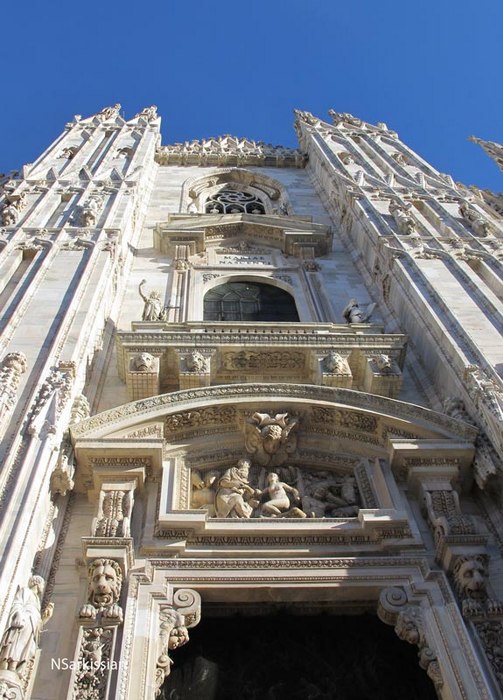
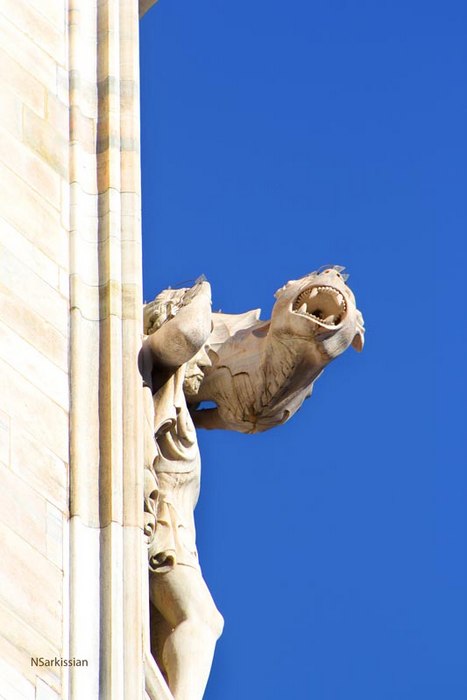

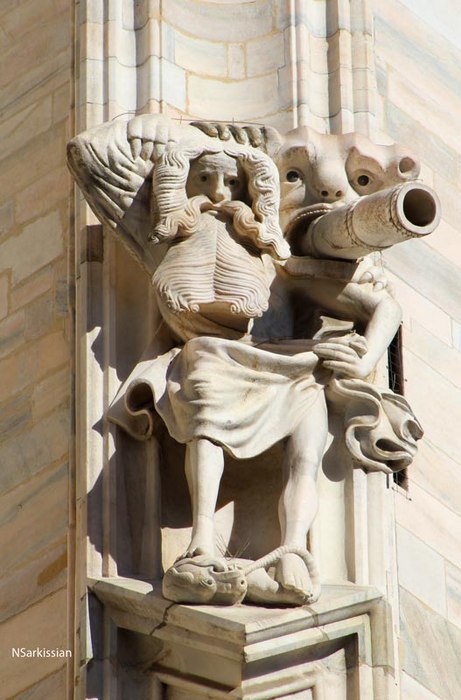

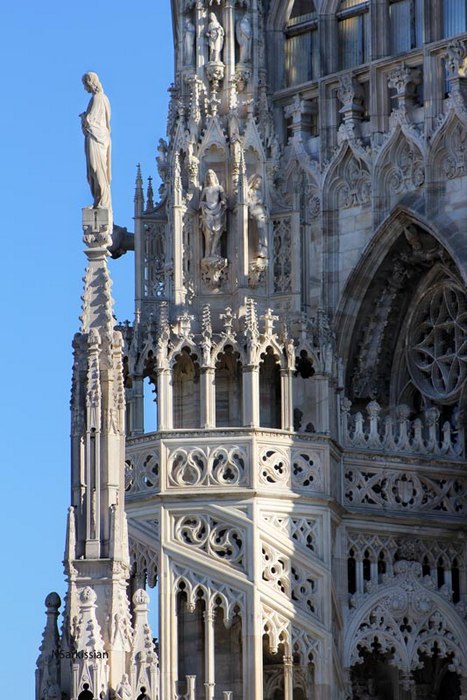
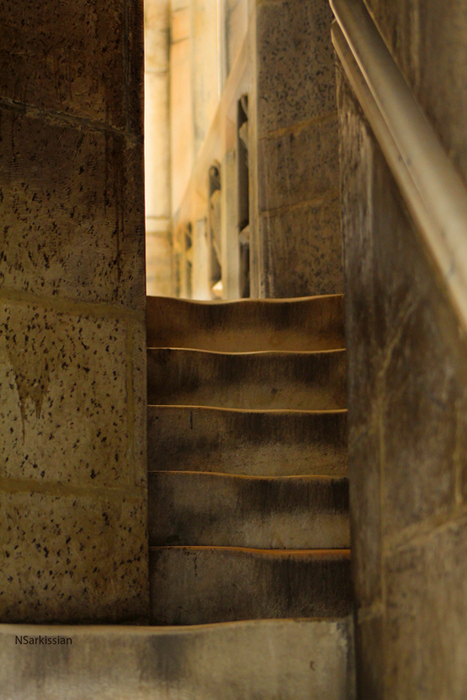

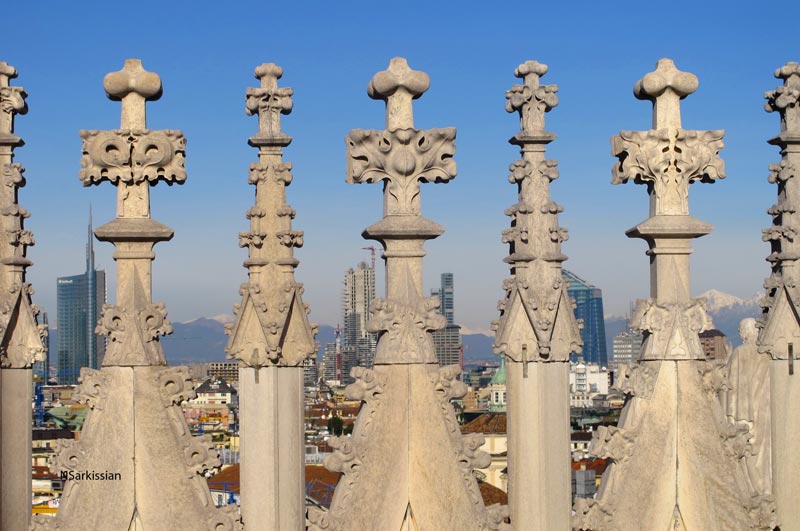
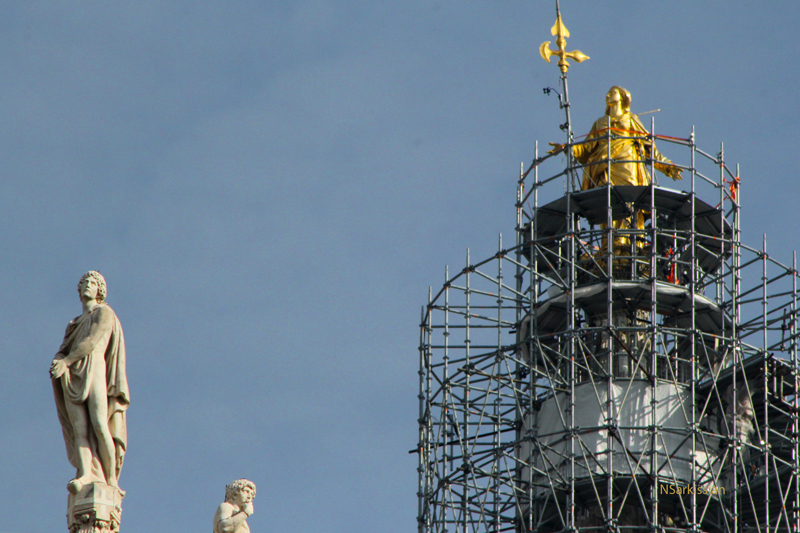
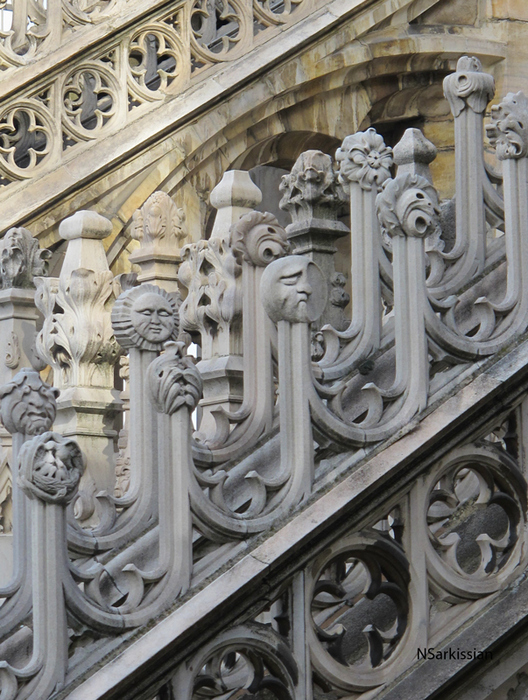

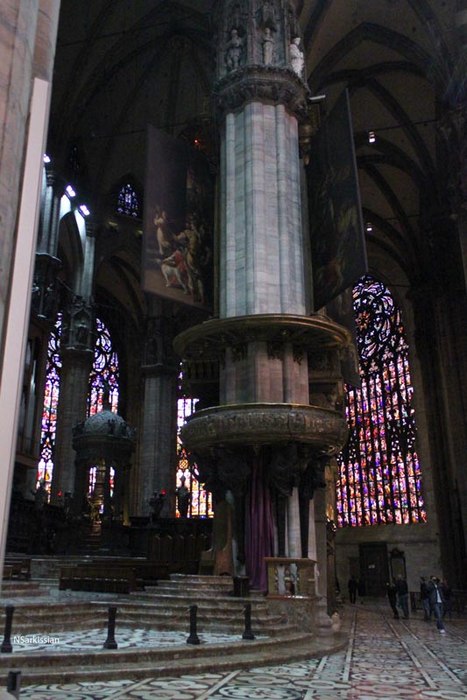


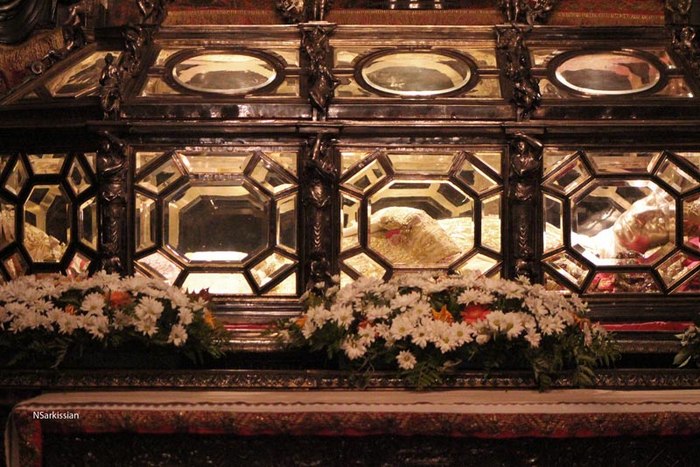
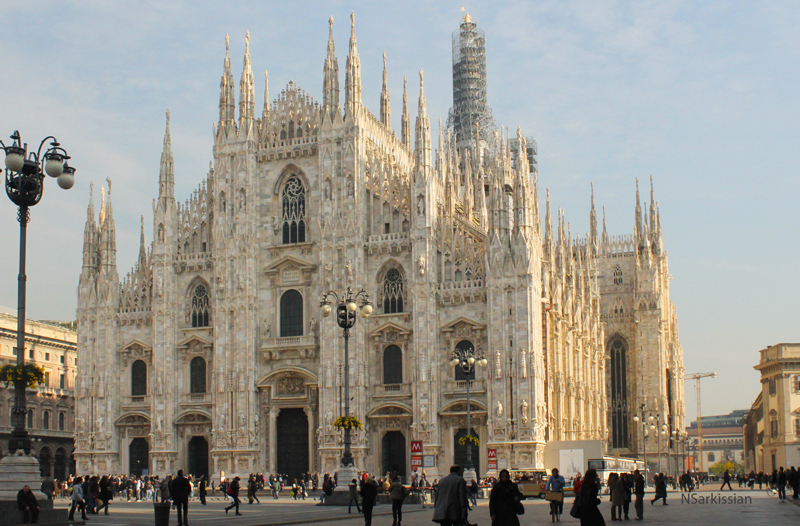

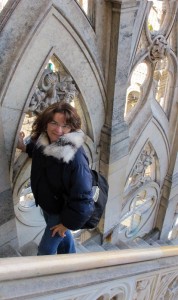
Thank you for this lovely essay, and the stunning compilation of related quotes from literary giants. A few years back I was fortunate enough to attend a conference in Milan and was housed at the Grand Duomo Hotel next door. I could stand on my bathtub and look out a small window at the cathedral, and the conference had a reception on the hotel roof; I felt I could reach over and touch the cathedral’s roof. And yes, I did tour the cathedral roof, stunned they allowed us up there. I went up the day before Lent began, and the square was packed with schoolkids in their Catholic school uniforms on field trips, and young people in colorful attire, their version of Fat Tuesday. Truly great to be brought back to that trip.
I’m glad you liked the essay and that it brought back your trip to the Duomo at Carnival. Thanks for lending your 21st century impressions to this collage.
So interesting to see the different perspectives on the Duomo’s aesthetic value. I’m tempted to say beauty is beside the point. It was meant to be spectacular, and it is, whether or not it’s beautiful. The photographs are stunning.
The Duomo is indeed spectacular. Thanks for your thoughts!
Your photographs are gorgeous. The text was both interesting and fully expanded by
your visual work.
Thanks!
Absolutely spectacular, and well beyond the usual tourist or coffee table shots. Felizitazioni ed auguri,
Sydney Lea
Grazie, Sydney, sei troppo gentile! So glad you enjoyed the essay.
Your photographs are absolutely breath-taking. I love the way you mix your own though with literary quotes. There is a lovely balance to the entire piece. You are simply brilliant.
Tiara, you’re too kind! Thank you so much!
Breathtaking!
Thanks AnnaMaria!
Dear Natalia,
I have been in Milan for three weeks before my final destination ( I left the US recently after losing my job and will recolate to Madrid where I plan to start anew and joyful). Upon arriving in Milan (not sure why I chose Milan for my soul break) and seeing the Duomo from afar, tears of joy came to my eyes. Today I visited the terrace at sunset and like the tourist you brighly described, I too used my Nikon as my diary of memories of such beauty, then searched for quotes to describe the uplift I feel, and found your post. Mark Twain put it into words, and you made it possible for me to find them. Not sure if you are in Milan this week, I leave wednesday to Madrid, but if you are here, drop me a note, it will be great to meet! What a beautiful city this is. Thanks again!
Beatriz,
So glad you found me, sorry to have seen this comment only today! I am glad you enjoyed your trip to the top of the Duomo and that it moved you. It would have been nice to have met in person, but now we’ve done so online. Happy New Year!
Lovely entry and pictures. Thanks
This is what brought me here:
In looking back on the scene into which we emerged from the stifling spiral of the ascent, I have chiefly a confused sense of an immense skyward elevation and a fierce blinding efflorescence of fantastic forms of marble. There, reared for the action of the sun, you find a vast marble world. The solid whiteness lies in slabs along the iridescent slopes of nave and transept, like the lonely snowfields of the higher Alps. It leaps and climbs and shoots and attacks the unsheltered blue with a keen and joyous incision. It meets the pitiless sun with a more than equal glow; the day falters, declines, expires, but the marble shines forever,
unmelted and unintermittent. You will know what I mean if you have looked upward from the Piazza at midnight. With confounding frequency, too, on some uttermost point of a pinnacle, its plastic force explodes into satisfied rest in some perfect flower of a figure. A myriad carven statues, known only to the circling air, are poised and niched beyond reach of human vision, the loss of which to mortal eyes is, I suppose, the gain of the Church and the Lord. Among all the jewelled shrines and overwrought tabernacles of Italy, I have seen no such magnificent waste of labour, no such glorious synthesis of cunning secrets.
From Travelling Companions by Henry James